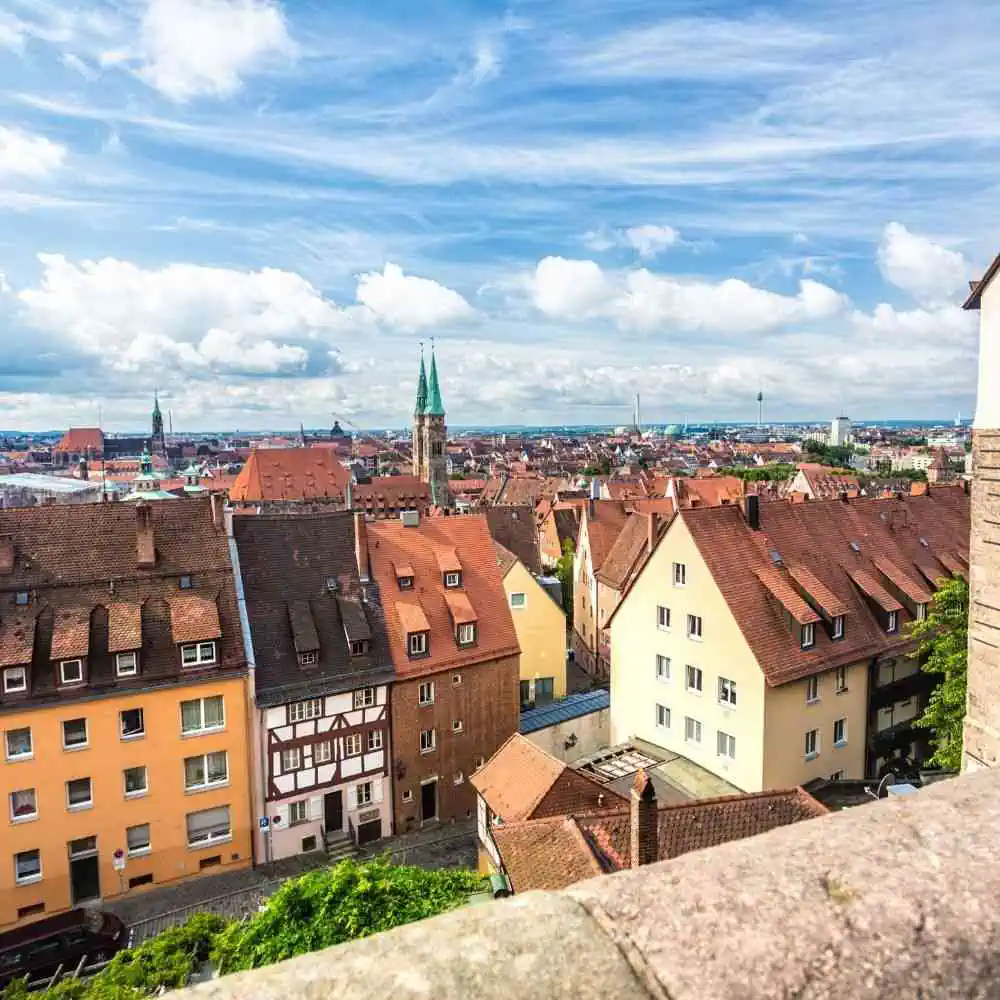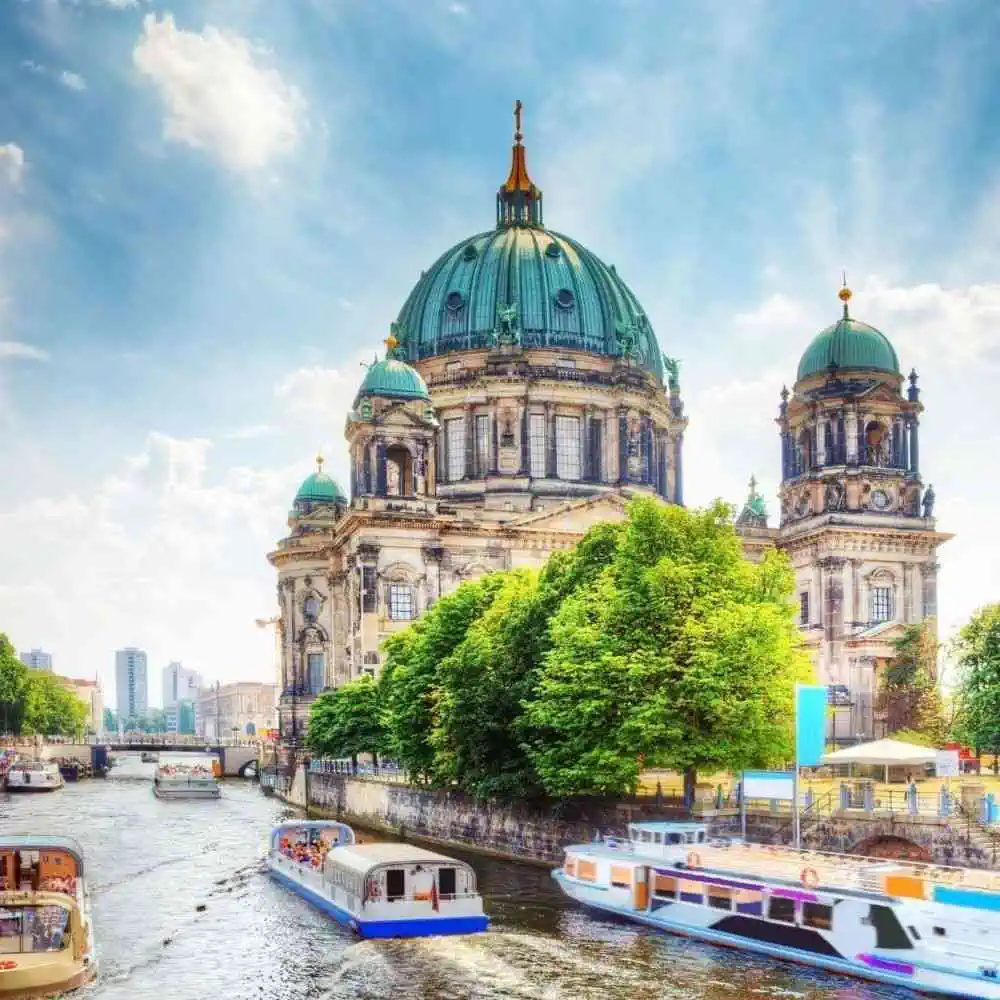You will depart from Berlin, located right in the city center of Berlin, and enjoy the beautiful scenery of the journey while you arrive in Nuremberg , also located in the heart of Nurnberg.
Trains from Berlin to Nurnbergfrom $ 58.58
Trains from Berlin to Nurnberg
Travelling by train: Berlin - Nurnberg
As you start your journey, you'll pass through the mesmerizing city of Dresden before crossing the Thuringian Forest and the Bavarian Rhön mountainous region. Other notable cities along the route include Halle, Leipzig, Erfurt, Eisenach, Fulda, and Würzburg. As you arrive in Nuremberg, you'll find many iconic buildings from the city's medieval past.
During the journey, make sure to take time to admire the lush Bavarian countryside and the vibrant cities along the route. From Berlin, you'll pass through a series of notable cities, towns, and villages, giving you an insight into classic German life. While the journey is relatively straightforward, there are countless sights and activities to enjoy in each city.
Make sure you don't miss the chance to explore the historic city center of Nuremberg. Visit the iconic Imperial Castle, the famous Sebalduskirche, or the unique Kaiserburg, a 11th century castle. Be sure to also take in the views from the Old Town Hall, explore the Altstadt, and experience the Nuremberg Christmas Market, a lively city tradition.
Traveling from Berlin to Nuremberg by train offers travelers a unique opportunity to explore the German countryside and discover some of the nation's most impressive cities along the way. With numerous places to visit and activities to enjoy, this is a journey you won't soon forget.

Journey details
How long does the train from Berlin to Nuremberg take?
The train takes approximately 4 hours and 20 minutes.
What is the fastest journey from Berlin to Nuremberg by train?
The fastest journey by train from Berlin to Nuremberg is 3 hours and 30 minutes.
How much does the train cost from Berlin to Nuremberg?
The cost of the train from Berlin to Nuremberg is €39.90.
How much does the Berlin to Nuremberg?
Yes, there is a direct train from Berlin to Nuremberg.
What is the distance from Berlin to Nuremberg by train?
The distance from Berlin to Nuremberg by train is approx. 300 Km.
Which are the cities that the train stops from Berlin to Nuremberg?
The train stops at cities including Leipzig, Erfurt, Bamberg, and Würzburg.
Buy train tickets from Berlin to Nurnberg
Traveling by train from Berlin to Nurnberg is an easy and comfortable journey. RailClick is the best way to travel Europe by train.
Berlin: Places to see
Berlin is a city full of history and culture, and it has plenty of attractions to visit for the perfect vacation. From famous landmarks and monuments to trying a wide variety of food, it is a city meant to be experienced. Here’s a list of the seven must-visit historical and architectural sites in Berlin so you can plan an exciting itinerary for your trip.
Brandenburg Gate: Built in 1791, this iconic landmark is the symbol of German unity. Visitors can find the Brandenburg Gate on Pariser Platz in central Berlin. It is free to visit, and the views of the city skyline at night are particularly stunning.
Reichstag Building: The Reichstag was completed in 1894 and houses Germany’s parliament. Visitors can take a tour of the building free of charge. The glass dome is a popular attraction, with its 360-degree views of Berlin.
East Side Gallery: This open-air gallery is located along the Spree River and features a mural painted in 1990 by 118 artists from around the world. Not only is it a spectacular sight in itself, but it’s also a memorial for the fall of the Berlin Wall.
Museumsinsel: This UNESCO World Heritage site is an island located in the Spree River and is home to five different museums: Pergamon Museum, Altes Museum, Neues Museum, Bode Museum and Alte Nationalgalerie. The Pergamon Museum has some of the world’s greatest ruins, and entrance fee depends on which museums visitors choose to attend.
Memorial to the Murdered Jews of Europe: This large memorial is made up of concrete stelae and spans across 4.7 acres in the center of Berlin. It is a powerful reminder of the millions of Jewish people who were murdered in the Holocaust.
Charlottenburg Palace: This rococo-style palace was built in the 17th century, and it is a popular attraction with tourists. Visitors can tour the palace and its extensive gardens for an entrance fee.
Kulturbrauerei: This is a former brewery that has been converted into an entertainment and cultural center. Visitors can enjoy live music, theatre, and comedy at the Kulturbrauerei, located in the heart of Berlin.
Aside from these key attractions, don’t forget to sample the local cuisine! Berlin is filled with delicious restaurants serving traditional German dishes, such as bratwurst and schnitzel. Head to a local beer garden or café to experience the best of Berlin’s culinary offerings. With its vast array of attractions, Berlin is the perfect holiday destination for history and culture-lovers alike.

Nurnberg: Places to see
Nuremberg (Nürnberg) in Germany is a small city with an impressive medieval-style architecture and an incredible array of historical sites. Here is a list of must-visit sights and delicious food that will make your trip unforgettable.
Imperial Castle: Standing tall on a sandstone ridge, the Imperial Castle was built in the 12th century and served as a residence of the Holy Roman Empire. Its architectural and historical significance earned it a spot on the UNESCO World Heritage List. You can explore the castle's courtyards, gardens, and towers. Location: Burgstraße 15, 90403 Nuremberg. Hours: 9:00 am–6:00 pm, 7 days a week. Entrance Fee: Adult 9€, Family 26€. Insider Tip: Check out the Katharinenkirche, the church built in honor of St. Catherine of Alexandria, located next to the castle.
Nuremberg Zoo: The Nuremberg Zoo is home to 900 different types of animals from around the world. It also has a petting zoo, aviary, and an ice cream parlor. Location: Am Tiergarten 30, 90439 Nuremberg. Hours: 9:00 am–6:00 pm, 7 days a week. Entrance Fee: Adult 15€, Family 50€. Insider Tip: Get there early to beat the crowds.
Germanisches Nationalmuseum: This museum provides insights into German culture and its history from the early middle ages to the present day. It houses a wide collection of artifacts and artworks. Location: Kartäusergasse 1, 90402 Nuremberg. Hours: 10:00 am–6:00 pm, Wed-Mon. Entrance Fee: Adult 10€, Reduced 8€. Insider Tip: Stop by the museum café for a coffee and a snack.
Nuremberg Christmas Market: The Nuremberg Christmas Market is one of Germany's biggest, with over two million visitors each year. You can enjoy traditional Christmas treats, holiday decorations, and live music. Location: Main square (Hauptmarkt). Hours: 10:00 am–8:00 pm, 7 days a week. Entrance Fee: Free. Insider Tip: Try the Nuremberg Bratwurst, the city's famous grilled sausages.
Swimming Pool: Nuremberg's public bathhouse, the Stadtbad, is a great place to relax and unwind. It has a variety of pools and saunas, plus a lazy river. Location: Sulzbachstrasse 91, 90489 Nuremberg. Hours: 9:00 am–10:00 pm, 7 days a week. Entrance Fee: Adult 6€, Kids 2€. Insider Tip: Bring your own towels from home and save money.
Albrecht Dürer House: This museum traces the life and work of the famous German painter and printmaker, Albrecht Dürer. It houses some of his most famous works, such as his famous painting of Adam and Eve. Location: Albrecht-Dürer-Straße 39, 90403 Nuremberg. Hours: 10:00 am–6:00 pm, Mon-Sun. Entrance Fee: Adult 7€, Reduced 4€. Insider Tip: Visit the nearby St. Sebald Church, which is often referred to as the Cathedral of Nuremberg.
Neustädter Markt: This popular public square in Nuremberg has been a center of city life since the 14th century. It's the perfect place to stroll and take in some of Nuremberg's history. Location: Neustädter Markt, 90402 Nuremberg. Hours: Always open. Entrance Fee: Free. Insider Tip: Stick around in the evening when the square is lit up and becoming more vibrant.
As you can see, Nuremberg offers a wide array of historical and cultural sights, as well as delicious food. Whether you're a history buff or a foodie, Nuremberg provides something for everyone. So take a stroll through the streets, explore the majestic castles, and enjoy some of the city's delightful cuisines. You won't be disappointed!

Berlin: Main train stations
Berlin, in Germany is home to several train stations, with Hauptbahnhof being the largest and most important. This main train station is the bustling heart of the city, with connections to all parts of city, as well as connecting to neighboring countries. In addition to Hauptbahnhof, there are several other smaller train stations in Berlin, such as Alexanderplatz, Südkreuz and Zoologischer Garten.
Hauptbahnhof is located on Washingtonplatz in the Moabit district and is open 24/7. It offers travelers services such as ticketing, luggage storage, souvenirs, ATM and exchange offices, as well as international call centers. The station is easily accessible by public transport and offers connections to a variety of places to visit, both inside and outside of Berlin. To find out more information, you can call the customer help line at +49 30 297 10.
- Berlin HBF
- Berlin Hbf (S-Bahn)
- Berlin-Brandenburg Flughafen
- Berlin Ostbahnhof
- Berlin Charlottenburg
- Berlin Spandau
- Berlin Sudkreuz (S)
- Berlin Gesundbrunnen
- Berlin Zoologischer Garten
- Berlin Potsdamer Platz
- Berlin Lichtenberg
- Berlin Hohenschonhausen
Nurnberg: Main train stations
Nürnberg is a major city in Germany and its main train station is the Nürnberg Hauptbahnhof. It is one of Germany's busiest train stations and is the hub for regional and long-distance trains. It is also connected to the underground, metro and tram network. Other important train stations in Nuremberg are Nürnberg-Langwasser, Nürnberg-Röthenbach and Nürnberg-Eckental.
Nürnberg Hauptbahnhof is located in Konrad-Adenauer-Platz 1 in the city. It is open 24/7 and the information desk can be reached by calling +49 911 9776215. Luggage storage is available and can be accessed inside the main entrance. The city of Nürnberg itself offers a lot to explore, including museums, galleries, churches, parks and more.
- Nuremberg
Berlin - Nurnberg: How to get the best deals
Book in Advance:
Just like with airfares, train ticket prices tend to rise as the departure date gets closer. Booking weeks or even months in advance can save you a significant amount.
Travel During Off-Peak Hours:
Avoid traveling during peak times such as weekday mornings and evenings. Opt for midday, late evening, or mid-week rides when there's less demand.
Consider Slower Trains or non direct routes:
Express or high-speed trains might save time, but they're often pricier. Opting for regional or slower services can reduce your fare.
Look for Special Deals and Promotions:
Train operators occasionally have promotions or special deals, especially during off-peak seasons. It's worth signing up for newsletters. Additionally, there are sometimes group or return ticket discounts, so consider these options if they fit your travel plans.
- Contact Us


